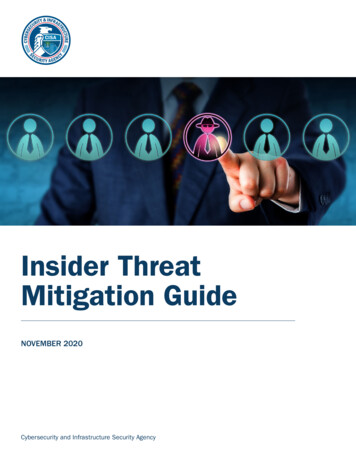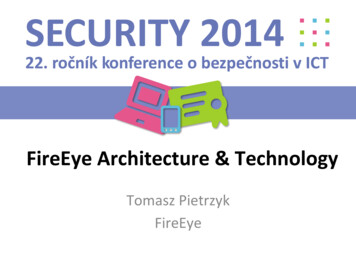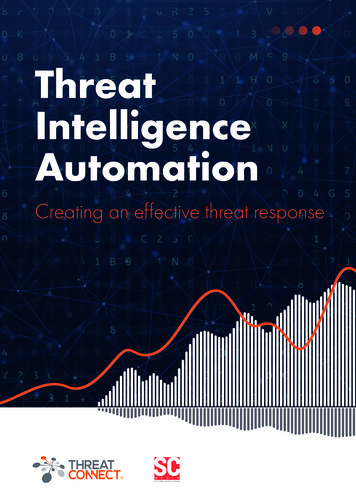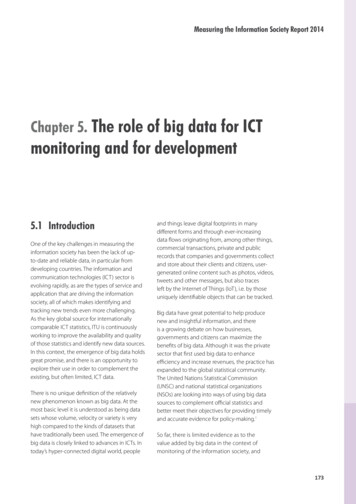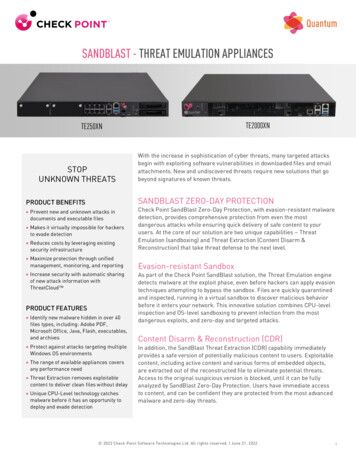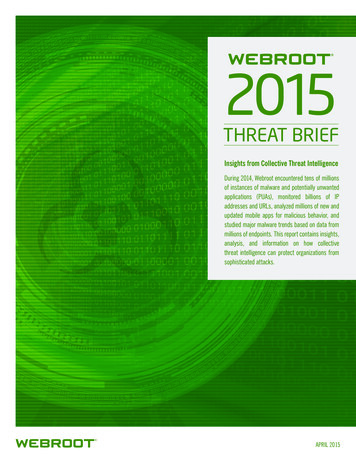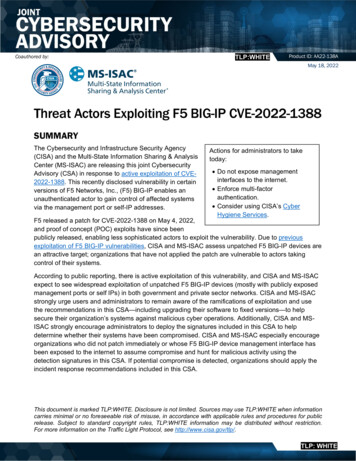
Transcription
Coauthored by:TLP:WHITEProduct ID: AA22-138AMay 18, 2022Threat Actors Exploiting F5 BIG-IP CVE-2022-1388SUMMARYThe Cybersecurity and Infrastructure Security Agency(CISA) and the Multi-State Information Sharing & AnalysisCenter (MS-ISAC) are releasing this joint CybersecurityAdvisory (CSA) in response to active exploitation of CVE2022-1388. This recently disclosed vulnerability in certainversions of F5 Networks, Inc., (F5) BIG-IP enables anunauthenticated actor to gain control of affected systemsvia the management port or self-IP addresses.Actions for administrators to taketoday: Do not expose managementinterfaces to the internet. Enforce multi-factorauthentication. Consider using CISA’s CyberHygiene Services.F5 released a patch for CVE-2022-1388 on May 4, 2022,and proof of concept (POC) exploits have since beenpublicly released, enabling less sophisticated actors to exploit the vulnerability. Due to previousexploitation of F5 BIG-IP vulnerabilities, CISA and MS-ISAC assess unpatched F5 BIG-IP devices arean attractive target; organizations that have not applied the patch are vulnerable to actors takingcontrol of their systems.According to public reporting, there is active exploitation of this vulnerability, and CISA and MS-ISACexpect to see widespread exploitation of unpatched F5 BIG-IP devices (mostly with publicly exposedmanagement ports or self IPs) in both government and private sector networks. CISA and MS-ISACstrongly urge users and administrators to remain aware of the ramifications of exploitation and usethe recommendations in this CSA—including upgrading their software to fixed versions—to helpsecure their organization’s systems against malicious cyber operations. Additionally, CISA and MSISAC strongly encourage administrators to deploy the signatures included in this CSA to helpdetermine whether their systems have been compromised. CISA and MS-ISAC especially encourageorganizations who did not patch immediately or whose F5 BIG-IP device management interface hasbeen exposed to the internet to assume compromise and hunt for malicious activity using thedetection signatures in this CSA. If potential compromise is detected, organizations should apply theincident response recommendations included in this CSA.This document is marked TLP:WHITE. Disclosure is not limited. Sources may use TLP:WHITE when informationcarries minimal or no foreseeable risk of misuse, in accordance with applicable rules and procedures for publicrelease. Subject to standard copyright rules, TLP:WHITE information may be distributed without restriction.For more information on the Traffic Light Protocol, see http://www.cisa.gov/tlp/.TLP: WHITE
CISA MS-ISACTLP:WHITETECHNICAL DETAILSCVE-2022-1388 is a critical iControl REST authentication bypass vulnerability affecting the followingversions of F5 BIG-IP:[1] 16.1.x versions prior to 16.1.2.215.1.x versions prior to 15.1.5.114.1.x versions prior to 14.1.4.613.1.x versions prior to 13.1.5All 12.1.x and 11.6.x versionsAn unauthenticated actor with network access to the BIG-IP system through the management port orself IP addresses could exploit the vulnerability to execute arbitrary system commands, create ordelete files, or disable services. F5 released a patch for CVE-2022-1388 for all affected versions—except 12.1.x and 11.6.x versions—on May 4, 2022 (12.1.x and 11.6.x versions are end of life [EOL],and F5 has stated they will not release patches).[2]POC exploits for this vulnerability have been publicly released, and on May 11, 2022, CISA addedthis vulnerability its Known Exploited Vulnerabilities Catalog, based on evidence of active exploitation.Due to the POCs and ease of exploitation, CISA and MS-ISAC expect to see widespread exploitationof unpatched F5 BIG-IP devices in government and private networks.DETECTION METHODSCISA recommends administrators, especially of organizations who did not immediately patch, to: See the F5 Security Advisory K23605346 for indicators of compromise.See the F5 guidance K11438344 if you suspect a compromise.Deploy the following CISA-created Snort signature:alert tcp any any - any HTTP PORTS (msg:”BIG-IP F5 iControl:HTTP POST URI‘/mgmt./tm/util/bash’ and content data ‘command’ and ‘utilCmdArgs’:CVE2022-1388”; sid:1; rev:1; flow:established,to server;flowbits:isnotset,bigip20221388.tagged; content:”POST”; http method;content:”/mgmt/tm/util/bash”; http uri; content:”command”;http client body; content:”utilCmdArgs”; http client body;flowbits:set,bigip20221388.tagged; tag:session,10,packets; reference:cve2022-1388; reference:url,github.com/alt3kx/CVE-2022-1388 PoC; priority:2;metadata:service http;)Additional resources to detect possible exploitation or compromise are identified below: Emerging Threats suricata signatures. Note: CISA and MS-ISAC have verified thesesignatures are successful in detection of both inbound exploitation attempts (SID: 2036546) aswell as post exploitation, indicating code execution (SID: 2036547).Page 2 of 5 Product ID: AA22-138ATLP: WHITE
CISA MS-ISACTLP:WHITEoSID 2036546alert http HOME NET any - EXTERNAL NET any (msg:"ET EXPLOIT F5 BIGIP iControl REST Authentication Bypass (CVE 2022-1388) M1";flow:established,to server; content:"POST"; http method;content:"/mgmt/tm/util/bash"; http uri; fast pattern;content:"Authorization 3a 20 Basic YWRtaW46"; http header;content:"command"; http client body; content:"run"; http client body;distance:0; content:"utilCmdArgs"; http client body; distance:0;http connection; content:"x-F5-Auth-Token"; nocase; http header names;content:!"Referer"; pass; reference:cve,2022-1388;classtype:trojan-activity; sid:2036546; rev:2; metadata:attack targetWeb Server, created at 2022 05 09, deployment Perimeter, deploymentSSLDecrypt, former category EXPLOIT, performance impact Low,signature severity Major, updated at 2022 05 09;)oSID 2036547alert http HOME NET any - any any (msg:"ET EXPLOIT F5 BIG-IPiControl REST Authentication Bypass Server Response (CVE 2022-1388)";flow:established,to client; flowbits:isset,ET.F5AuthBypass;content:"200"; http stat code; file data; content:"kind";content:"tm 3a util 3a bash 3a runstate"; fast pattern; distance:0;content:"command"; distance:0; content:"run"; distance:0;content:"utilCmdArgs"; distance:0; content:"commandResult";distance:0; reference:cve,2022-1388; classtype:trojan-activity;sid:2036547; rev:1; metadata:attack target Web Server, created at2022 05 09, deployment Perimeter, deployment SSLDecrypt,former category EXPLOIT, performance impact Low, signature severityMajor, updated at 2022 05 09;) Palo Alto Networks Unit 42 Threat Brief: CVE-2022-1388. This brief includes indicators ofcompromise. Note: due to the urgency to share this information, CISA and MS-ISAC have notyet validated this content.Cisco Talos Intelligence Group - Comprehensive Threat Intelligence: Threat Advisory: CriticalF5 BIG-IP Vulnerability. This blog includes indicators of compromise. Note: due to theurgency to share this information, CISA and MS-ISAC have not yet validated this content.Randori’s bash script. This script can be used to identify vulnerable instances of BIG-IP. Note:MS-ISAC has verified this bash script identifies vulnerable instances of BIG-IP.Page 3 of 5 Product ID: AA22-138ATLP: WHITE
CISA MS-ISACTLP:WHITEINCIDENT RESPONSEIf an organization’s IT security personnel discover system compromise, CISA and MS-ISACrecommend they:Quarantine or take offline potentially affected hosts.Reimage compromised hosts.Provision new account credentials.Limit access to the management interface to the fullest extent possible.Collect and review artifacts such as running processes/services, unusual authentications,and recent network connections.6. Report the compromise to CISA via CISA’s 24/7 Operations Center (report@cisa.gov or888-282-0870). State, local, tribal, or territorial government entities can also report to MSISAC (SOC@cisecurity.org or 866-787-4722).1.2.3.4.5.See the joint CSA from the cybersecurity authorities of Australia, Canada, New Zealand, the UnitedKingdom, and the United States on Technical Approaches to Uncovering and Remediating MaliciousActivity for additional guidance on hunting or investigating a network, and for common mistakes inincident handling. CISA and MS-ISAC also encourage government network administrators to seeCISA’s Federal Government Cybersecurity Incident and Vulnerability Response Playbooks. Althoughtailored to federal civilian branch agencies, these playbooks provide operational procedures forplanning and conducting cybersecurity incident and vulnerability response activities and detail stepsfor both incident and vulnerability response.MITIGATIONSCISA and MS-ISAC recommend organizations: Upgrade F5 BIG-IP software to fixed versions; organizations using versions 12.1.x and 11.6.xshould upgrade to supported versions.If unable to immediately patch, implement F5’s temporary workarounds:o Block iControl REST access through the self IP address.o Block iControl REST access through the management interface.o Modify the BIG-IP httpd configuration.See F5 Security Advisory K23605346 for more information on how to implement the aboveworkarounds.CISA and MS-ISAC also recommend organizations apply the following best practices to reduce risk ofcompromise: Maintain and test an incident response plan.Ensure your organization has a vulnerability program in place and that it prioritizes patchmanagement and vulnerability scanning. Note: CISA’s Cyber Hygiene Services (CyHy) arefree to all SLTT organizations and public and private sector critical infrastructureorganizations: https://www.cisa.gov/cyber-hygiene-services.Page 4 of 5 Product ID: AA22-138ATLP: WHITE
CISA MS-ISACTLP:WHITE Properly configure and secure internet-facing network devices.o Do not expose management interfaces to the internet.o Disable unused or unnecessary network ports and protocols.o Disable/remove unused network services and devices. Adopt zero-trust principles and architecture, including:o Micro-segmenting networks and functions to limit or block lateral movements.o Enforcing multifactor authentication (MFA) for all users and VPN connections.o Restricting access to trusted devices and users on the networks.REFERENCES[1] K23605346: BIG-IP iControl REST vulnerability CVE-2022-1388[2] K11438344: Considerations and guidance when you suspect a security compromise on a BIG-IPsystemPage 5 of 5 Product ID: AA22-138ATLP: WHITE
F5 released a patch for CVE-2022-1388 on May 4, 2022, and proof of concept (POC) exploits have since been publicly released, enabling less sophisticated actors to exploit the vulnerability. Due to . previous . exploitation of F5 BIG-IP vulnerabilities, CISA and MS-ISAC assess unpatched F5 BIG-IP devices are



